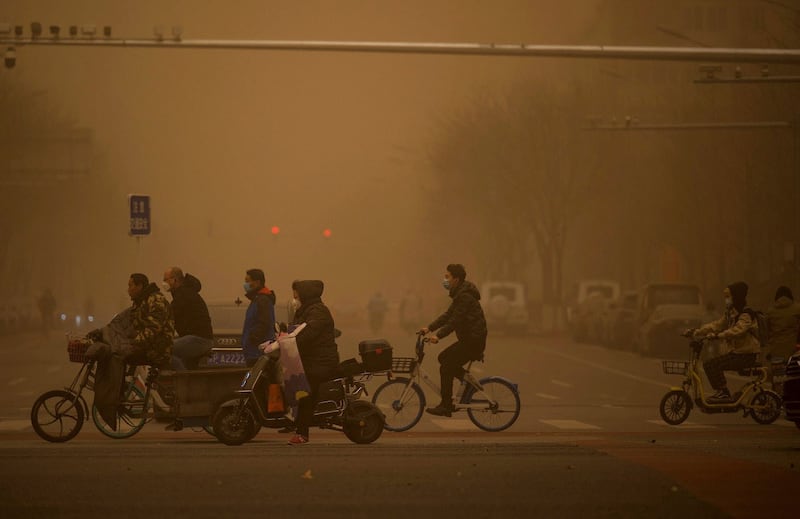Beijing's 21 million residents saw familiar buildings and landmarks swathed in a thick, orange haze on Monday, as sandstorms swept across the region, bringing unprecedented air pollution in their train.
As the sandstorm peaked, levels of PM10 particulates showed readings beyond the scale of the instruments designed to measure them, with local residents saying they could barely see things a few hundred meters away.
According to the Beijing environmental monitoring center, the concentration of PM10 particulates exceeded 8,000 micrograms per cubic meter in parts of Beijing on Monday.
"I'm at the airport, getting ready to go on a business trip," Beijing resident Li Hua told RFA on Monday morning.
"Visibility is very poor; it's foggy and kind of orange, and visibility is only about one kilometer," she said.
Airport authorities at two airports -- Capital and Daxing -- said they had canceled more than 20 percent of flights owing to the pollution.
Fengtai district resident Chen Guoming said trains on Beijing's subway were running slower than usual on Monday.
"The subway trains were slower this morning," Chen said. "Maybe it was because of the winds."
Retired meteorology official Zhang Baikui said the sandstorm was a level 8 in intensity.
"The sandstorm is still very serious, and it will go on like this for 24 hours," Zhang told RFA. "Most people are just staying home, unless they have no choice but to go to work."
The China Meteorological Administration said via its official account on the social media platform Weibo that this was the worst sandstorm to hit the region in a decade.
It said huge swathes of northern and northwestern China were affected, with sand and dust drifting across areas of Xinjiang, Inner Mongolia, Gansu, Ningxia, Shaanxi, Shanxi, Hebei, Beijing, and Tianjin, with sandstorms in some areas.

'Orange everywhere'
A resident of Beijing's Daxing district surnamed Liu said the entire city was enveloped in the orange dust.
“It was really orange everywhere, even underfoot," Liu said. "This was when the storm was very severe, and it went on like that until 9.30 a.m."
"My driver said that around five o’clock in the morning, visibility was really poor, barely 10 meters."
"We haven't had such a huge sandstorm in Beijing in 20 years," she said.
A Beijing resident surnamed Sun said things had improved slightly later in the day.
"Air pollution in Beijing is pretty bad today, although it is a little better now [than before][, maybe because there is now a bit of a wind," she said.
Social media users quipped that "Operation Blue Sky" clearly still had some time to run, in a reference to Feb. 25 comments from air pollution czar Liu Bingjiang, who claimed that "Operation Blue Sky" had exceeded its goals, and that "the battle to keep our skies blue has been won."
Others posted memes joking that NASA's Perseverance Rover, that is currently sending back photos featuring large quantities of orange dust from Mars, was really in Beijing.
In the northern region of Inner Mongolia, six people -- including a five-year-old child -- were reported dead and dozens missing in the area around the Gobi Desert, which local authorities said was the source of the sandstorms.
Search parties were being formed to look for more than 80 members of herding communities still missing in the storms, that whipped through the region over the weekend, local media reported.
Inner Mongolia’s grasslands are under extreme environmental stress from desertification and pollution from Chinese mining, tree-felling and other resource extraction activities.
Reported by Qiao Long and Lau Siu Fung for RFA's Mandarin and Cantonese Services. Translated and edited by Luisetta Mudie.
